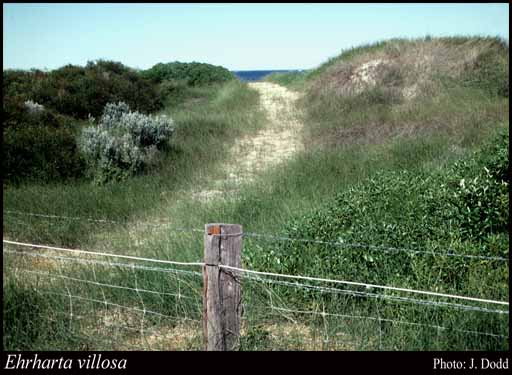- Reference
- Roem. & Schult., Syst.Veg. 7:1374 (1830)
- Conservation Code
- Not threatened
- Naturalised Status
- Alien to Western Australia
- Name Status
- Current
Slender rhizomatous, perennial, grass-like or herb, to 1.5 m high. Fl. purple-green, Oct to Dec or Jan. Sand. Coastal sand dunes & limestone.

Distribution
- IBRA Regions
- Coolgardie, Esperance Plains, Jarrah Forest, Swan Coastal Plain, Warren.
- IBRA Subregions
- Eastern Goldfield, Perth, Recherche, Southern Jarrah Forest, Warren.
- IMCRA Regions
- Central West Coast, Leeuwin-Naturaliste, WA South Coast.
- Local Government Areas (LGAs)
- Albany, Augusta Margaret River, Busselton, Cockburn, Dandaragan, Denmark, Esperance, Gingin, Irwin, Kalgoorlie-Boulder.
Management Notes (for the Swan NRM Region)
General Biology. Growth form. Grass. Life form. Perennial, rhizomatous. Reproduction. Rhizomes, possibly seed. Dispersal. Inappropriate plantings for dune stabilization. Photosynthetic Pathway. C3. Seedbank persistence. Short to medium term, days-5 years. Fire response. Resprouts.
Notes. Adapted to warm temperatures, a range of light intensities and habitats with mobile sand. Is an aggressive invader of dunes, where it is known to smother native flora. Populations tend to senesce in dune systems where sand movement has been reduced. Culms become largely dormant during winter, although root and rhizome growth continues. Has adaptions to reduce water loss and survive in dry environments, including sunken reduced stomata and in-rolled leaves. Vegetative spread can be rapid, however establishment from seedlings in naturalised populations including areas in New Zealand has been poor.
Additional information. Origin. South Africa. History of use/introduction. Dune stabilisation.
Suggested method of management and control. Spray with Verdict 520® 10 ml/10 L (500 ml/ha) or glyphosate 1% + penetrant. Several sequential applications will likely be required. Read the manufacturers' labels and material safety data sheets before using herbicides. For further information consult the Australian Pesticides and Veterinary Medicines Authority to determine the status of permits for your situation or state.
Management Calendar
| Calendar Type | Jan | Feb | Mar | Apr | May | Jun | Jul | Aug | Sep | Oct | Nov | Dec | Comments |
|---|---|---|---|---|---|---|---|---|---|---|---|---|---|
| Dormant | O | O | O | ||||||||||
| Active Growth | Y | O | Y | Y | Y | Y | |||||||
| Flowering | Y | Y | Y | Y | Y | ||||||||
| Optimum Treatment | Y | Y | Y | Y | Y | Y | Y |
Legend: Y = Yes, regularly, O = Occasionally, U = Uncertain, referred by others but not confirmed.
References
- Brown, K. & Brooks, K. (2002) Bushland Weeds: A Practical Guide to their Management. Environmental Weeds Action Network, Greenwood.
- Harrington, K.C., Hodder, L.M. & Outred, H.A. (1998) Biology and Control of Pypgrass. In 51st New Zealand Plant Protection Conference. New Zealand Plant Protection Society.
- Hilton, M., Harvey, N. & James, K. (2007) The impact and management of exotic dune grasses near the mouth of the Murray River, South Australia. Australasian Journal of Environmental Management, 14: 220-230.
- Hoare, D.B. (Undated) Ehrharta villosa Schult. F. Food and Agriculture Organisation of the United Nations URL: http://www.fao.org/ag/AGP/agpc/doc/Gbase/Safricadata/ehrvill.htm - Accessed November 2009.
- Hussey, B.M.J., Keighery, G.J., Dodd, J., Lloyd, S.G. & Cousens, R.D. (2007) Western Weeds. A guide to the weeds of Western Australia. 2nd Edition. The Plant Protection Society of Western Australia, Victoria Park.
- Moore, C.B. & Moore, J.H. (2002) Herbiguide, the pesticide expert on a disk. Herbiguide, PO Box 44 Albany, Western Australia, 6330.
- Moore, J.H. & Wheeler, J. (2008) Southern weeds and their control. DAFWA Bulletin 4744.
- USDA, ARS, National Genetic Resources Program (2009) Germplasm Resources Information Network - (GRIN). National Germplasm Resources Laboratory, Beltsville, Maryland. URL: https://npgsweb.ars-grin.gov/gringlobal/taxon/taxonomysimple.aspx - Accessed October 2009.